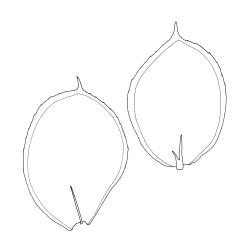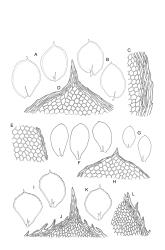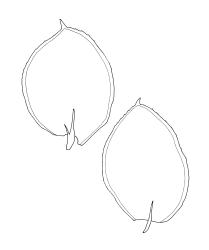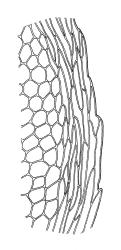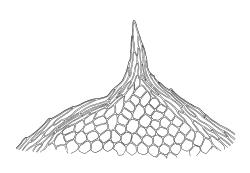- ≡ Hookeria apiculata Hook.f. & Wilson, London J. Bot. 3: 549 (1844)
- ≡ Eriopus apiculatus (Hook.f. & Wilson) Mitt., J. Linn. Soc., Bot. 12: 393 (1869)
- = Eriopus tasmanicus Broth., Öfvers. Finska Vetensk.-Soc. Förh. 42: 109 (1900)
- ≡ Calyptrochaeta apiculata var. tasmanica (Broth.) Fife, Bryologist 98: 315 (1995)
- = Distichophyllum platyloma Müll.Hal., Hedwigia 41: 121 (1902)
Plants small to medium-sized, rigid or soft, yellow-, brown-, or bright green, mostly weakly iridescent, forming loose turves. Stems sparsely branched, erect, yellow- to red-brown in older portions, 10–20 mm long, in cross-section with a coloured, subcortical region of firm-walled cells, lacking a central strand, c. 200–350 µm diam., with abundant, golden-brown, smooth rhizoids arising at leaf bases. Shoots mostly 4–5 mm wide. Leaves firm or less often delicate in texture, inserted in 6 ranks, weakly or moderately crisped when dry, becoming more closely overlapping and larger in upper portions, those in dorsal and ventral ranks symmetric, broadly elliptic, those in lateral ranks asymmetric, elliptic to ± obovate, tapered to obtuse, stoutly apiculate apices, plane at margins, strongly bordered throughout, entire to irregularly serrate in upper half, (1.5–)1.8–3.0 × 1.3–2.0 mm; upper laminal cells firm-walled, weakly thickened in corners, 30–45 × 30–36 µm, becoming gradually larger towards base; marginal cells elongate, thick-walled and porose, forming a concolorous border (5–)6–8(–10) cells and (33–)51–75(–80) µm wide throughout. Costa very short to nearly absent, bifurcating at base or less often single, extending to ⅕ the length of the leaf but generally shorter.
Dioicous. Perichaetial leaves ovate-acuminate, ecostate, unbordered, c. 1.4–1.7 mm (including acumen). Perigonia ovoid, c. 1 mm, scattered along ♂ stem, with outer bracts shaped as perichaetial bracts and inner bracts broadly obtuse and yellow-brown, apparently without paraphyses. Setae 5–10 mm, ± straight, stout (c. 200 µm diam.), papillose or less often smooth, pale yellow-brown; capsules erect to inclined, symmetric, 1.0–1.5 mm, smooth when dry, red-brown; operculum not seen. Exostome teeth c. 300 µm long; endostome with rudimentary cilia. Calyptra not seen. Spores 18–24 µm, smooth.
Sainsbury 1955, pl. 64, fig. 3 (as Eriopus); Streimann 2000, fig. 1; Meagher & Fuhrer 2003, p. 33; Smith 2004, fig. 231, 10–11.
NI: N Auckland (Piha, Huia) including offshore islands (LB), Wellington (Somes I., Mokopuna I., Pencarrow, Wharekauhau); SI: Nelson (Kaihoka, D’Urville I., Kōhaihai Bluff, Three Mile Creek, Dolomite Point), Marlborough (Motuara I., Ship Cove Scenic Reserve, Port Underwood), Canterbury (Banks Peninsula), Westland (near Hokitika, Ōkārito Estuary, Jackson Bay), Otago, Southland (Dusky Sound, Hump Ridge, Bluff Hill); St (widespread); Ch; Sol; Sn; A; Ant; C. Reported from M by Seppelt (2004).
Austral. Tasmania*, Australia*, Marion I.*, Argentina*, Falkland Is.*, Chile*. Adventive in Britain*.
Predominantly a coastal species in N.Z., and tolerant of salt spray. In coastal situations growing on sand, humus, or directly on rock (basalt, granite), in stream beds or seeps, and rarely on stumps/logs, or as an epiphyte (on Olearia sp.) in coastal scrub. It favours but is not restricted to sheltered vertical banks. In limestone areas it grows on thin humus or debris mats rather than directly on rock. Linzey (in herb.) recorded it from the "round raised bases of Leptocarpus simplex [and] Scirpus nodosus in salt marsh" and "covering several acres in this habitat" at Aramoana (Otago L.D.). Material from inland sites has been seen from Stewart I. It is a particularly common species on Stewart I. (from which both inland and coastal material has been seen) and apparently also on other offshore southern islands. Mainly restricted to areas of salt spray at low elevations but ranging to 305 m (Dan Rogers Creek, Banks Peninsula) and to c. 860 m at Hump Ridge.
Vitt (1979) recorded it as "common on the Auckland Islands at lower elevations on peaty margins of hummocks and banks. It is particularly characteristic of overhanging banks in association with Orthodontium lineare, Fissidens leptocladus, Rhizogonium novae-hollandiae, and R. distichum. [It] is nearly confined to these habitats subject to salt spray."
Both perigonia and sporophytes are rare in New Zealand material and, like Sainsbury, I have seen fruit only in material from Stewart I. In Australia, including Tasmania, this species is apparently markedly less coastal in its distribution than in N.Z. It is reported from a wide range of forest and scrub vegetation types in Australia (Streimann 2000; Meagher & Fuhrer 2003).
In Great Britain, C. apiculata is recorded from coastal localities in the Isles of Scilly and East Sussex where it is "almost certainly introduced from the southern hemisphere with horticultural plants" (Smith 2004).
Material from inland sites (mostly from Stewart I.) often has leaves that are more delicate in texture, and more iridescent than material from coastal sites. I have previously (Fife 1995) named such material as C. apiculata var. tasmanica (Broth.) Fife (Bryologist 98: 315, 1995) but no longer consider this taxon worthy of recognition. In this I concur with Streimann (2000).
The var. β, proposed by Wilson & Hooker (Wilson 1854, p. 122) has no nomenclatural standing. Wilson & Hooker cite a "single stem only" collected by Colenso on the North I. I have not seen this material, but consider it unlikely to deserve taxonomic recognition.



